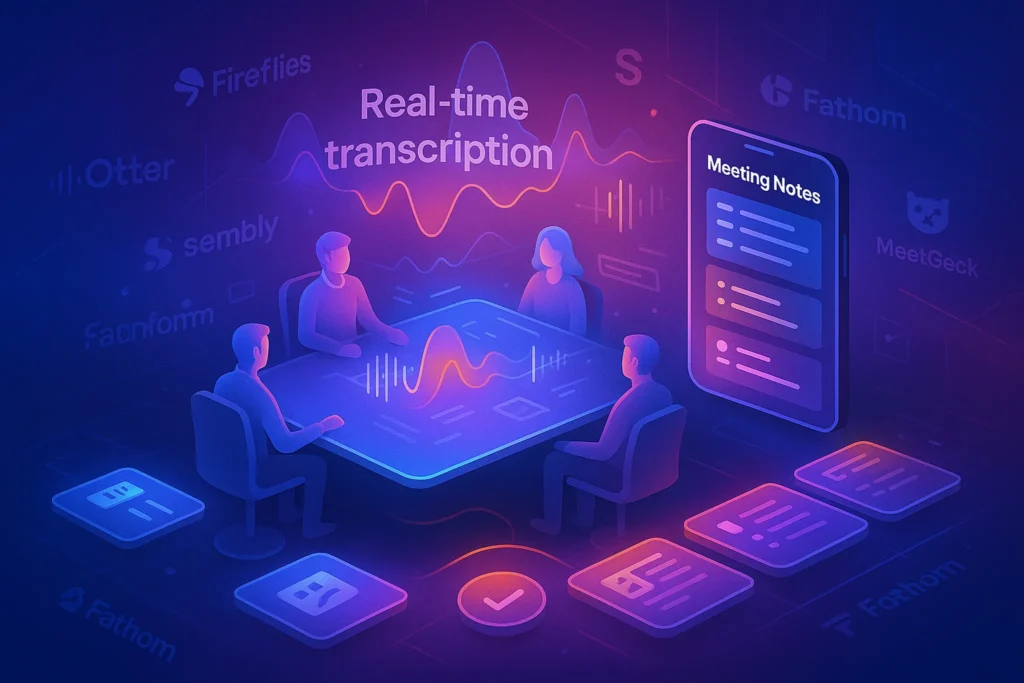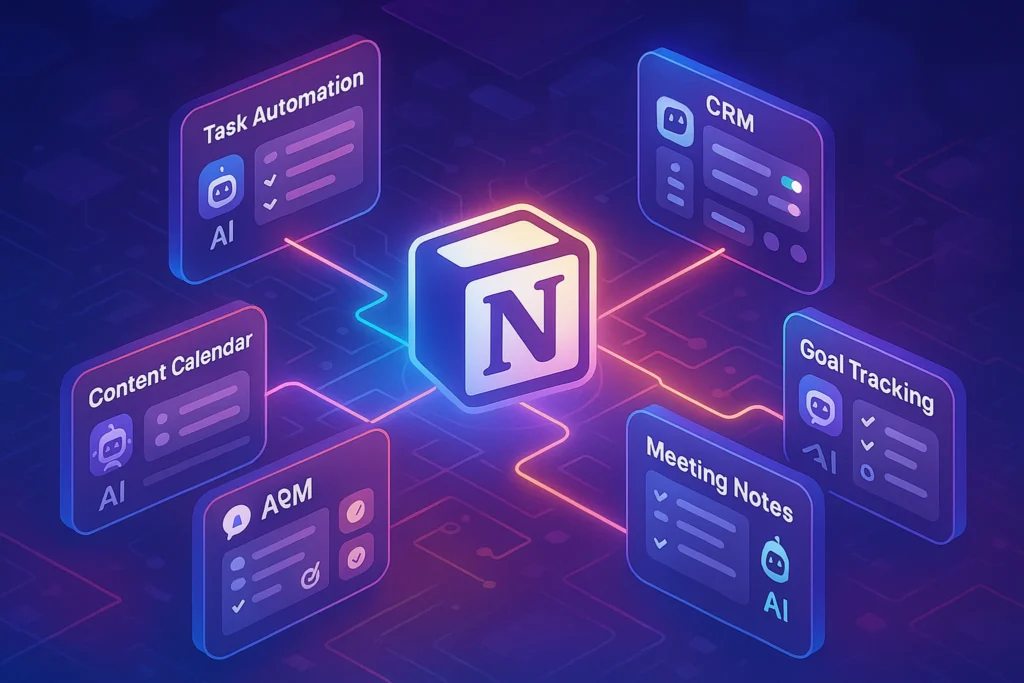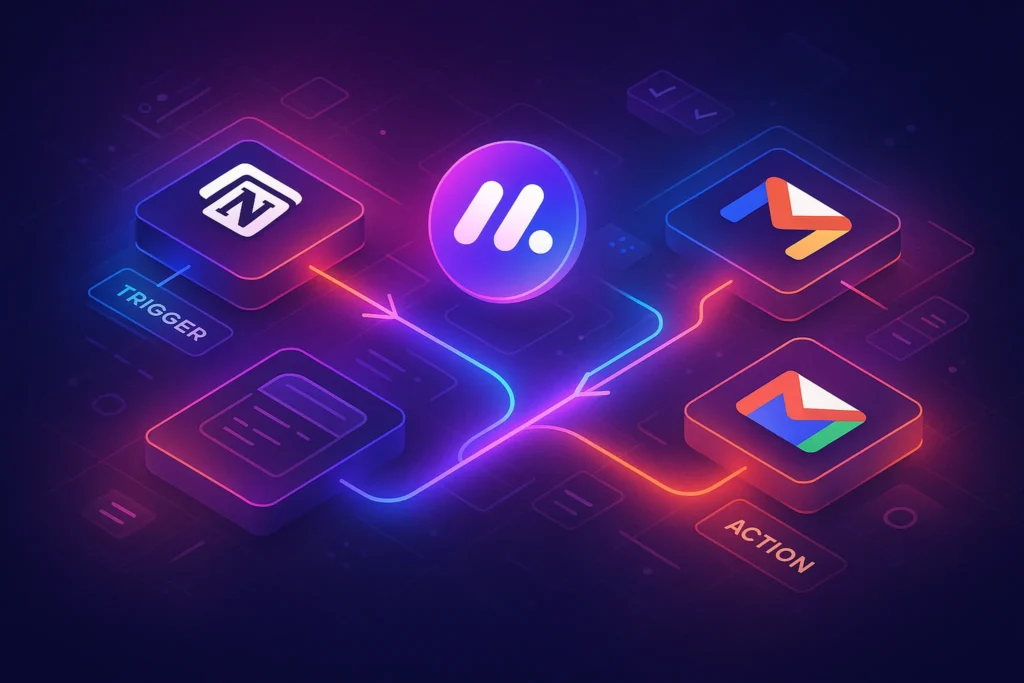-This post may contain affiliate links. If you click on one and make a purchase, I may earn a small commission at no extra cost to you.-
🚀 Introduction – The Remote Work Evolution Needs Smarter Tools
Remote work isn’t a trend—it’s now the standard for fast-moving teams and startups. But let’s be honest: staying aligned, productive, and organized across time zones is hard. From juggling Slack messages at midnight to chasing updates across docs and tools, remote collaboration can quickly turn into remote confusion.
💡 That’s where AI-powered tools come in. These aren’t your average Zoom add-ons—they’re real productivity drivers designed to:
-
Summarize meetings on the fly
-
Centralize conversations and tasks
-
Help distributed teams make faster decisions
-
Keep everyone in sync, without daily standups
In this post, we’ve handpicked the top AI collaboration tools for remote teams in 2025. Whether you’re managing async sprints or brainstorming across continents, these tools can save you hours—and sanity.
🧰 The Best AI Tools for Remote Collaboration
Here’s our curated lineup of AI tools that can revolutionize the way your remote team communicates, collaborates, and crushes deadlines.
1. 💬 Slack + Slack AI
Why It Matters:
In remote teams, chat overload can kill productivity. Slack AI helps streamline collaboration with features like smart summaries, thread suggestions, and AI-generated replies—making Slack more intelligent and less chaotic.
Real Use Case:
A development team has a long bug discussion in a channel. Slack AI summarizes key points, action items, and decisions—no more digging through endless threads.
Practical Scenarios:
-
Smart Summaries: Catch up on a busy channel in seconds.
-
Suggested Replies: Speed up conversations with AI-generated response options.
-
Thread Detection: Automatically suggests threads when the topic shifts.
Best For:
Teams deeply integrated into Slack that want faster communication without reading every message.
Nerd Verdict: “Still the king of remote team chat—now smarter.”
Key Features:
-
Smart summaries of long threads
-
AI-powered message suggestions
-
Thread auto-tagging for topics
-
Workflow automations via Slackbot
✅ Pros
-
Huge integration library
-
Familiar UX
-
Great for async work
❌ Cons
-
Can get noisy without good channel discipline
-
Slack AI features not yet free
🧠 Best for: Distributed teams that live in Slack 24/7
2. 🎙️ Fathom AI
Why It Matters:
Most meetings go undocumented. Fathom records, transcribes, and highlights Zoom calls automatically—turning conversations into actionable follow-ups.
Real Use Case:
Sales teams highlight key objections and customer needs in live calls, then use Fathom’s synced notes to drive pipeline actions.
Practical Scenario:
You host 5 calls in one day. Instead of writing notes, Fathom captures everything, creates bullet summaries, and syncs to your CRM instantly.
Nerd Verdict: “Turn every Zoom meeting into searchable insights.”
Key Features:
-
Records, transcribes & summarizes Zoom calls
-
Auto-generates follow-up notes
-
Chrome extension for fast access
-
Integrates with CRM & Notion
✅ Pros
-
Free plan available
-
Great search/filter by speaker/topic
-
Instant recap sharing
❌ Cons
-
Only works with Zoom
-
No mobile app yet
🧠 Best for: Remote teams with heavy video call workflows
🔗 Related: Check our guide to best AI meeting assistant tools
3. 🗂 Notion AI
Why It Matters:
For remote teams, asynchronous alignment and centralized knowledge are hard to maintain. Notion AI boosts collaboration by generating summaries, structuring notes, and offering contextual AI prompts directly within documents.
Real Use Case:
Marketing teams use Notion AI to turn scattered meeting inputs into structured weekly reports and action items.
Practical Scenario:
A remote content team across four time zones inputs raw notes. Notion AI transforms them into clean documentation with clear next steps—no human editor needed.
Nerd Verdict: “Your team wiki, now with a brain.”
Key Features:
-
Generate meeting agendas & notes
-
Smart task assignments
-
Summarize long docs or comments
-
AI writing assistant built-in
✅ Pros
-
Unified workspace
-
Integrates with Slack, Jira, etc.
-
Excellent templates
❌ Cons
-
Can feel slow on large docs
-
Learning curve for new teams
🧠 Best for: Remote teams managing projects and docs centrally
4. 🤖 ClickUp AI
Why It Matters:
Remote project management lives or dies on clarity. ClickUp AI creates task lists, user stories, meeting summaries, and project docs—faster than any human.
Real Use Case:
Product managers turn meeting notes into actionable tasks and timelines within seconds.
Practical Scenario:
You finish a roadmap meeting. Paste your notes into ClickUp, and AI breaks them into sprints, assigns owners, and flags blockers.
Nerd Verdict: “Project management meets automation wizardry.”
Key Features:
-
AI summarization of updates
-
Smart suggestions for task priorities
-
Natural language task creation
-
Collaborative whiteboards with AI notes
✅ Pros
-
Highly customizable
-
Free plan with generous features
-
Central hub for all team ops
❌ Cons
-
Overwhelming for small teams
-
Some AI features in paid plans only
🧠 Best for: Mid to large remote teams juggling multiple workflows
5. 📅 Motion
Why It Matters:
Calendar chaos kills productivity. Motion schedules and reschedules your tasks automatically—based on deadlines, meetings, and focus time.
Real Use Case:
Busy solopreneurs and startup teams rely on Motion to create real “deep work” blocks amid chaotic calendars.
Practical Scenario:
Have 12 random tasks and 3 calls? Motion uses AI to prioritize, auto-schedule, and update your day dynamically.
Nerd Verdict: “The AI calendar that thinks like a PM.”
Key Features:
-
Auto-schedules tasks based on deadlines
-
Prioritizes team workload
-
Reschedules around meetings dynamically
-
Chrome & mobile apps
✅ Pros
-
Smart time blocking
-
Real-time team visibility
-
Reduces scheduling chaos
❌ Cons
-
Takes time to trust the AI
-
UI can feel dense
🧠 Best for: Teams juggling multiple priorities and deadlines
6. 📤 Loom + Loom AI
Why It Matters:
Async teams need clarity. Loom AI adds summaries, chapters, and searchable transcripts to your video messages automatically.
Real Use Case:
Engineering leads record Looms to explain complex bugs or changes. Loom AI turns them into digestible briefs with timestamps.
Practical Scenario:
You send a 4-minute product update. Loom AI creates a 3-bullet summary, tags chapters, and auto-generates a title that boosts views.
Nerd Verdict: “Async video updates just got more powerful.”
Key Features:
-
Record and transcribe videos instantly
-
AI-generated highlights and chapters
-
Embed in docs or tools
-
Quick share links
✅ Pros
-
Perfect for async updates
-
Saves time vs live meetings
-
Mobile and desktop friendly
❌ Cons
-
Limited interactivity
-
Not ideal for feedback loops
🧠 Best for: Remote updates, demos, and async onboarding
7. 🔹 Krisp
Why It Matters:
Bad audio breaks communication. Krisp uses AI to remove background noise on both ends of the call—in real time. Whether it’s a barking dog or a busy café, Krisp ensures crystal-clear voice.
Real Use Case:
Remote support agents working from home or co-working spaces use Krisp to sound professional and noise-free during client calls.
Practical Scenarios:
-
You’re in a noisy coffee shop. Krisp eliminates chatter and espresso machine sounds.
-
On Zoom, even your client’s dog won’t distract you—Krisp blocks their background too.
-
No need for fancy gear or switching locations.
Key Features:
-
Bi-directional noise cancellation
-
Works across Zoom, Teams, Slack Huddles
-
Lightweight and optimized for remote workflows
Best For:
Remote professionals who want to sound studio-level sharp in any environment.
8.🔹 Fellow AI
Why It Matters:
Meetings can quickly turn into unproductive time sinks—especially when follow-ups, agendas, or notes are missing. Fellow AI is built specifically to help remote teams manage and improve the quality of their meetings with structured agendas, real-time collaboration, and smart summaries.
Real Use Case:
A remote product team has weekly syncs. With Fellow AI, they pre-define agendas, collaborate during the meeting in real time, and automatically generate action items and recaps. Everyone stays aligned, even across time zones.
Practical Scenarios:
-
Meeting Agendas: Share agenda templates in advance to keep meetings focused.
-
Real-Time Collaboration: Take notes collaboratively during calls.
-
Action Items & Follow-Up: Auto-extract next steps so nothing slips through the cracks.
-
Feedback Integration: Built-in peer feedback tools for improving team performance.
Key Features:
-
Collaborative meeting notes
-
AI-generated agendas & recaps
-
Integration with Google Meet, Zoom, MS Teams
-
Feedback & performance tools
Best For:
Teams that run frequent 1:1s, team syncs, or leadership meetings and want to turn them into high-value sessions.
9.🔹 Grain
Why It Matters:
Remote calls contain valuable insights—but most get lost after the meeting. Grain captures, transcribes, and summarizes Zoom meetings, making it easy to extract key moments, share them with your team, and search across past calls.
Real Use Case:
A customer success manager runs a call with a client. Instead of manually summarizing, they use Grain to automatically highlight key insights and send a 2-minute recap video to the team.
Practical Scenarios:
-
Clip Important Moments: Mark highlights in real time or after the meeting.
-
Auto-Transcription: Instantly searchable transcripts for reviewing calls.
-
Sync with Slack & Notion: Push highlights directly to internal tools.
-
Use AI for Summaries: AI generates quick recaps and titles for shared clips.
Key Features:
-
Zoom integration
-
AI-generated highlights & recaps
-
Team knowledge base
-
Instant sharing of clips via link or Slack
Best For:
Teams who want to turn meetings into searchable, shareable knowledge—especially in sales, product, and support.
💡 Nerd Tip:
While AI-powered platforms are transforming how remote teams collaborate, sometimes the most effective systems come from tried-and-true, non-AI solutions. If your team values simplicity, stability, and human-centered workflows, you’ll want to check out our Top Non‑AI Collaboration Tools for Remote Teams (Simple, Reliable & Proven)—a curated guide to tools like Slack, Zoom, Notion, and Trello that get the job done without the algorithmic complexity.
📊 Quick Comparison Table
| Tool | Best Use Case | AI Feature Highlight | Free Plan | Verdict |
|---|---|---|---|---|
| Slack AI | Team chat & async ops | Smart thread summarization | ✅ | Best Overall Chat |
| Fathom | Zoom call insights | Real-time meeting summaries | ✅ | Best for Meetings |
| Notion AI | Knowledge management | Doc generation + task assist | ✅ | Best All-in-One |
| ClickUp AI | PM + workflow automation | AI summaries, task prediction | ✅ | Best for Teams |
| Motion | Time blocking & calendar | Smart scheduling + reshuffling | ❌ | Best for Prioritizing |
| Loom AI | Async comms | Video transcript + highlights | ✅ | Best for Updates |
| Krisp | Noisy work environments | AI noise removal (bi-directional), works with all platforms | ✅ | Best Audio Clarity |
| Fellow AI | 1:1 & Team Meeting Management | Auto-generating agendas and recaps for weekly syncs | ❌ | Best for Meetings |
| Grain | Zoom Meeting Highlighting | Highlighting customer insights from Zoom calls | ✅ | Best for Research Teams |
🧠 Nerd Verdict
If your remote team feels scattered across tools and time zones, these AI platforms can pull everything into focus. Our top pick? Notion AI for knowledge + project ops, and Fathom for making meetings useful again.
❓ FAQ – AI for Remote Collaboration
What’s the best AI tool for remote team notes?
👉 Fathom auto-summarizes Zoom calls and delivers editable meeting notes instantly.
Can AI really improve team productivity?
Yes. AI tools reduce manual admin, improve clarity, and allow async alignment across teams—vital for remote work.
Which free AI tools are best for startups?
Start with Slack AI (limited), Fathom, Loom, and Notion AI—all offer free plans with usable features.
💬 Would You Bite?
Which AI tool is a must-have for your remote workflow?
Share your stack in the comments 👇



